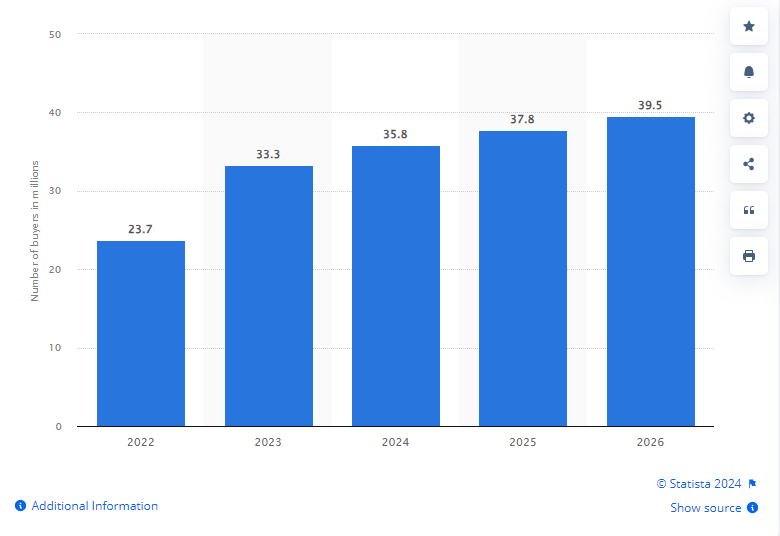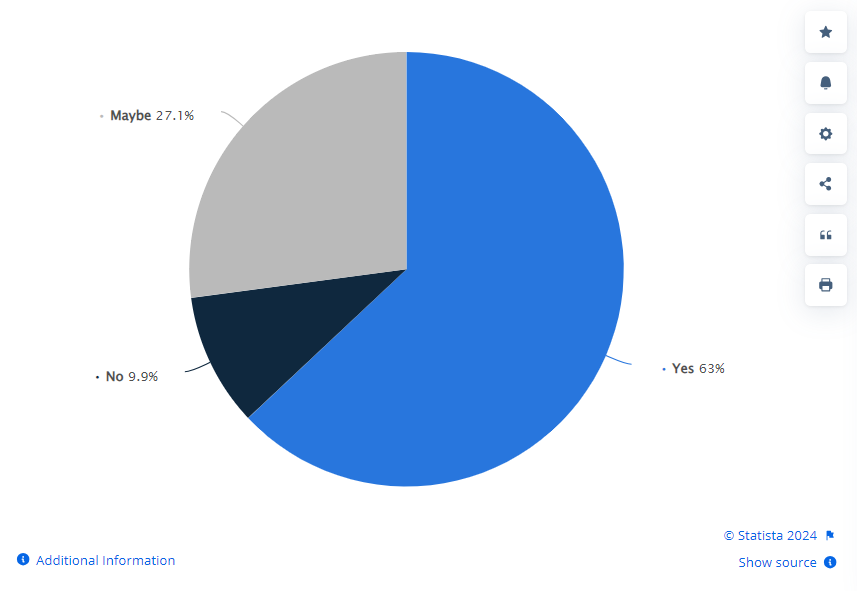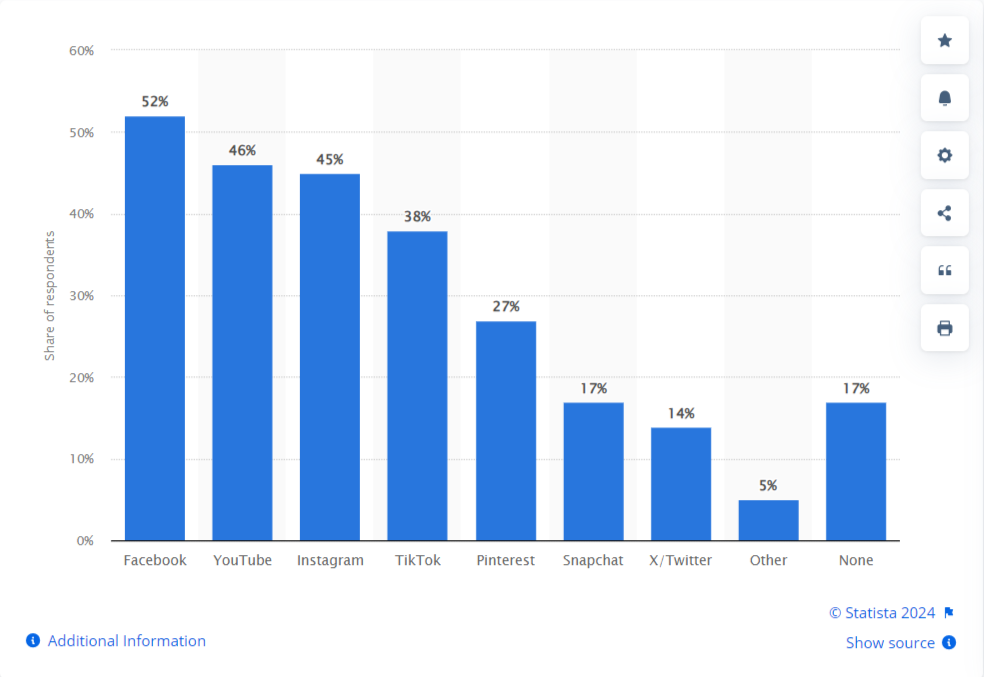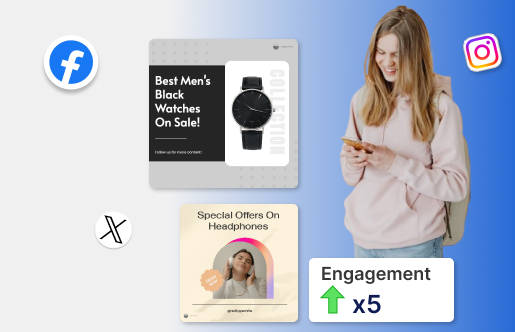Social media has become a dynamic tool for both buying and selling products in 2024. Businesses are leveraging various social media platforms to directly reach and engage with customers, driving increased sales and brand visibility.
Simply put, social commerce involves merging e-commerce functionalities with popular social media platforms like Instagram, Facebook, and TikTok. This integration streamlines the entire purchasing journey—from product discovery and selection to checkout and delivery—within a single online environment.
Read on as we explore the key social commerce statistics for 2024 that can inform and inspire your marketing strategies.
Top Social Commerce Statistics to Explore in 2024
Below are some essential social commerce statistics for 2024 that can shape your marketing strategies and business decisions:
1. Generational Adoption of Social Commerce
Social commerce may have gained momentum with Gen-Z, but with social media integrating an easier interface, the older generation is slowly implementing social commerce into their buying experience.
With 81% of Gen X using Facebook and 62% using Instagram in 2024, they make up a significant chunk of people browsing the internet. Here are some social commerce statistics that show the exact number of people investing in social commerce:
- Gen X makes up 25% of the total population to buy from online influencers in the US. 51% of them buy from brands, and 54% from retailers online.
- Currently, millennials and Gen Z buy the most from social media shops, with 66% of the buyers getting things on social media.
- They are also the top ones to discover products and brands regularly from social media, among the 69% of Gen Z and 71% of Millennials who use social media.
2. Dominant Social Commerce Platforms
Facebook, Instagram, and TikTok are some of the most famous platforms for social commerce. Here are some key indices:
- Facebook Marketplace remains one of the most used social commerce platforms, with 40% of the platform’s 3.07 billion users shopping here, and 16% open the app solely for buying products from the Marketplace.
- Instagram is second in line after Facebook, where people purchase products. 70% of the users discover products on the platform, and 46% use the app’s checkout facility.

- TikTok is emerging as a leading platform for selling products, with 35.8 million people buying from the platform in 2024, which is 2.5 million more than the buyers in 2023.
3. Social Commerce Revenue Growth
The social commerce world is ever-growing, and the numbers are proof of the same. Here are some significant statistics:
- Social commerce is growing steadily in the US, as it saw a boom of 0.3% between 2024 and 2023, with the amount changing from $56.2 billion to $67.3 billion.
- Social commerce is expected to touch the $ 100 billion mark globally by the year 2025, seeing 22.5% growth from the previous year.
- Some driving forces that are changing these social commerce statistics significantly are changing consumer preferences, technological advances, and increased social media use over the years.
4. Explosive Revenue Growth
Advanced technology like virtual human or AI influencers is becoming famous in the social commerce market, and the findings show positive turnovers in the last few years.
In China, WeChat is evolving how people buy and sell products online. The country has become the leading country to utilize the power of this platform for buying and selling products online.
Here are a few things to consider:

- 63% of buyers look forward to integrating AI and machine learning for influencer marketing in 2025.
- 50% of the people using AI influencer marketing were highly satisfied with the results and were positive about its importance in online marketing.
- 31.7% of people were in favor of AI influencer marketing because of the ease of use, and 29.1% were happy about the 24*7 assistance.
- China’s social commerce market has grown significantly over the years, seeing a 40.25% spike in market size between 2021 and 2023.
- In the first quarter of 2023, WeChat had 1.33 billion active users in China, which includes about 80% of the country’s population.
- WeChat Mini Programs Stores has revolutionized the way people are using WeChat, and the platform is now an emerging social commerce site.
5. Ethical Marketing Growth
Sustainability and ethical selling are becoming essential concerns for buyers, and sellers are adhering to these changing preferences to increase sales. People are now looking for environmentally friendly brands that do not use malpractices while manufacturing and selling products.
Here are some social commerce statistics that show why sustainability and ethical marketing are crucial for buyers:
- 66% of global consumers are ready to pay more to buy sustainable products, and 10% of them are already buying sustainable goods.
- 35% of the buyers stopped buying goods from unethical services on social media, even if there were no other alternatives.
- 29% of consumers buying ethical products take to social media, and 58% feel good after investing in ethical sellers.
6. Building Customer Relationships
Trust is a significant factor when it comes to social media purchases. If a consumer trusts a brand, they are more likely to invest in the brand and continue shopping for it in the future.
- 81% of the customers are influenced by posts and buying preferences of their friends and close ones.
- 78% made purchases after understanding and liking the posts on the brand’s page.
- People are twice as likely to purchase from brands they have heard about or have made purchases from in the past.
- While TikTok is the most trusted app among Gen Z, it is the least trusted among the older generations.
Businesses must try building trust with their customers to increase ROI by generating organic traffic.
Boost Sales on Social Media with AI ⚡️
TRY NOW7. Influencer Marketing Trends
With social media like TikTok and Instagram saturated with influencers, it is not surprising that they are one of the most used marketing strategies for social commerce businesses in 2024.
Audiences following influencers look up to them for new ideas and products to purchase. Here’s how influencer marketing is shifting social commerce trends:
- A large number of influencers collaborate with brands that are 15 times smaller than their pages.
- Influencers take an active interest in the selling process, with 58% of them taking an active interest in planning a strategy and 42% wanting to know the details about the kind of content that needs to be on social media for the products.
- 80% of the influencers use the products they partner with, which can increase consumer reliability and drive sales.
8. Rise of Short-Form Video Content
With decreasing attention spans on social media, people are slowly shifting to short-form content. This is also the reason why businesses are now integrating reels into their social media marketing strategy.
Here are some social commerce statistics that highlight the growing use of short-form content each year:
- YouTube shorts have more than 2 billion viewers, making YouTube a powerful selling platform.
- 18% of marketers show a high success rate of videos less than 30 seconds, and 39% find the 30- to 60-second-long video best for marketing.
- Over 50% of social platform sellers use short-form content for their sales.
- At 90%, short-form content will rule the traffic driving force for the internet, with short-form video ad revenue touching $10 billion.
9. Global Social Commerce Trends
Social commerce has different patterns in each country, and understanding these patterns can help increase local SEO tremendously. The following data shows some social commerce trends in Asian and Western countries:
- Thailand and Columbia are the forerunners in the social commerce market, with 91% of buyers using social media for buying products, and China is a close competitor at 90%.
- The conversion rates are high in Thailand, with 62% of the total population using social commerce to buy from social media.
- About 36% of US buyers are social media buyers, and at least 90 million consumers have used at least one social media platform for buying products.
- Asian countries remain at the top of the social commerce buying chain, with 11.7% of the total e-commerce sales coming from social commerce, in comparison to the US, where 4.4% buy from social commerce.
- Social buyers will increase to $86.7 billion in 2024 and to $107.17 billion in 2025, showing an exponential growth in market size, but China will still lead the way.

10. Customer Behavior Influencing Social Commerce Surge
With online shopping, discovering new brands has become much easier and quicker. The internet algorithm picks up on browsing preferences and starts showing stores based on search history, and this has increased the possibility of a product getting purchased.
Buying sprees during the holiday season or the discount season are crucial factors to consider when thinking about behavioral patterns and how they affect sales.
There are a few social commerce statistics to consider in this regard:
- 34% of buyers online used social media to purchase items during the holiday season in 2023.

- 52% of the purchases made during the holiday season were influenced by Facebook and 46% of buyers took inspiration from Instagram.
- Almost 40% of online shoppers were influenced by social media discounts during their purchases.
- Convenience and exclusivity were among the top motivators for purchases on social media at 31% and 27%, respectively.
- 48% of the buyers made impulsive buys using social media marketing, and it has led to significant growth in the social commerce market.
Final Thoughts
By leveraging these key statistics and insights, businesses can optimize their approach to meet evolving consumer demands and drive sustainable growth in the dynamic realm of social commerce.
And when it comes to consumers and customers, understanding their preferences, behaviors, and motivations is crucial for developing effective social commerce strategies.

⭐️⭐️⭐️⭐️⭐️
Best Shopify app for Social Media Marketing
You may also like,



















